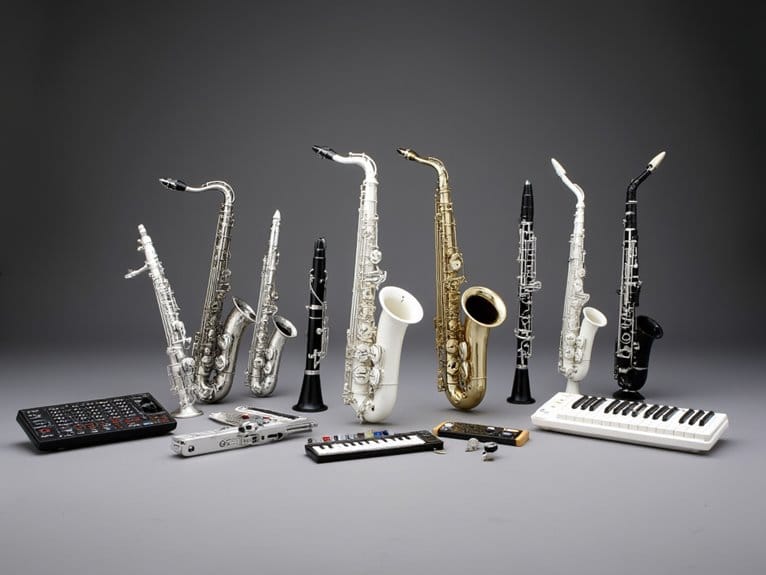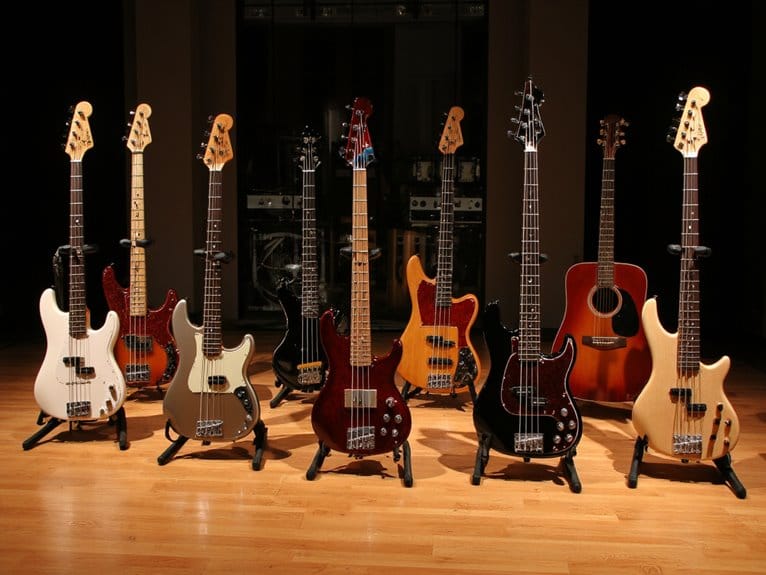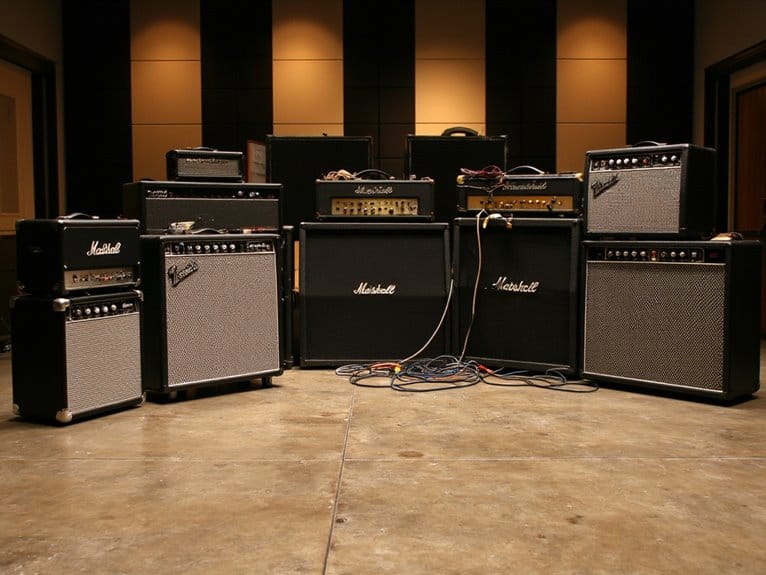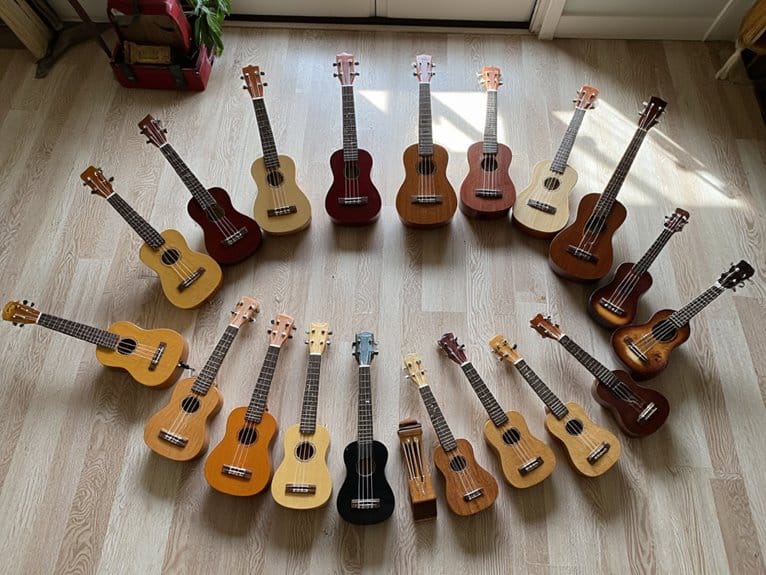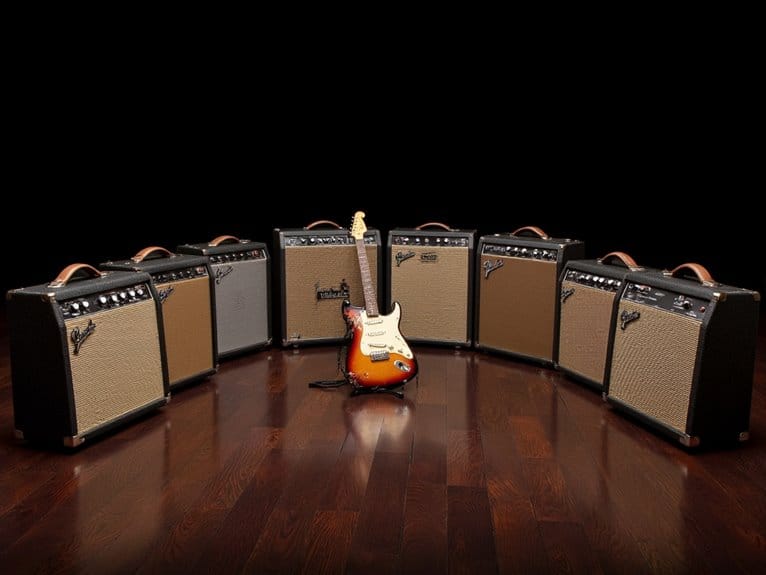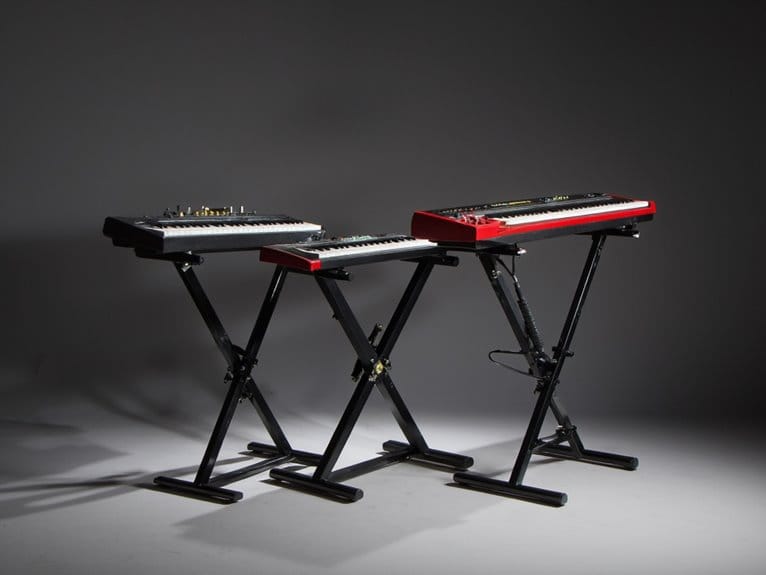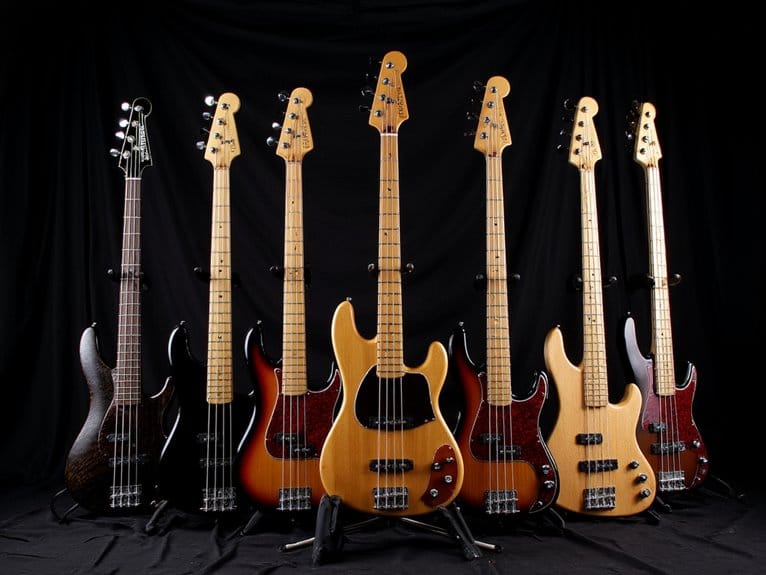10 Best Electronic Wind Instruments for Musicians of All Levels
I’ve tested numerous electronic wind instruments, and the standout models include the Electronic Digital Wind Instrument i99 with its 103 sounds and four fingering systems, the AP 300 Pro featuring professional recording capabilities and zero-latency Bluetooth, and the beginner-friendly KONIX DC02 Pro with ten built-in tones. The ultra-portable Vangoa EWI-100 weighs just 11.3 ounces, while the AKAI Professional EWI5000 offers extensive MIDI control across multiple fingering modes. Each instrument balances portability, connectivity, and sound versatility differently, so understanding their specific strengths will help you make the right choice.
We are supported by our audience. When you purchase through links on our site, we may earn an affiliate commission, at no extra cost for you. Learn more.
Notable Insights
- Electronic wind instruments offer versatile sound options with 10-103 different tones and multiple fingering systems for various skill levels.
- MIDI connectivity and Bluetooth pairing enable integration with apps, DAWs, and external devices for enhanced creative possibilities.
- Portability ranges from ultra-lightweight 11.3-ounce models to heavier 4.4-pound options, with battery life spanning 4-8 hours typically.
- Beginner-friendly models feature intuitive controls and adjustable breath sensitivity, while professional versions include LCD displays and recording capabilities.
- Price considerations include evaluating built-in recording, connectivity options, tone variety, and battery performance against individual musical needs.
Electronic Digital Wind Instrument i99 with Wireless EWI
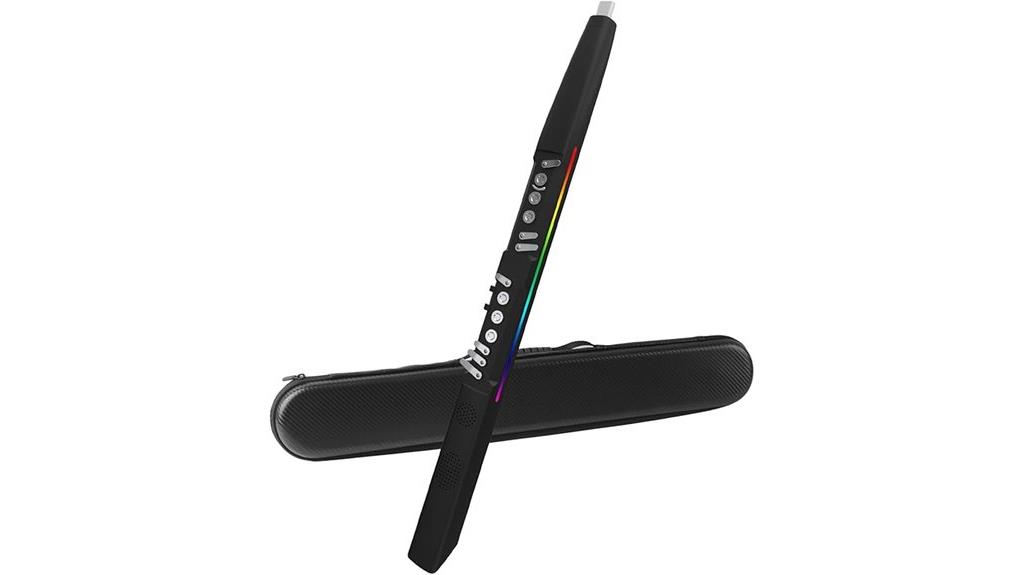
When I first encountered the Electronic Digital Wind Instrument i99, I was struck by its ambitious approach to bridging traditional wind playing techniques with modern digital versatility, making it an ideal choice for musicians who want to explore beyond conventional saxophone, flute, or specialty instruments like hulusi without investing in multiple physical instruments. You’ll find 103 sounds paired with four distinct fingering systems, while the 10 adjustable sensitivity levels accommodate everyone from tentative beginners to experienced players who’ve developed their breath control over years of practice. The connectivity options impressed me most—two built-in speakers, Bluetooth pairing, MIDI compatibility, and both headphone and amp outputs provide remarkable flexibility for practice sessions, recording, or live performances.
Best For: Musicians seeking a versatile digital wind instrument that supports multiple playing styles and fingering systems while offering extensive connectivity options for practice, recording, and performance.
Pros:
- 103 sounds with 4 different fingering systems (saxophone, flute, electric flute, hulusi) provide exceptional versatility in one instrument
- Comprehensive connectivity including Bluetooth, MIDI, headphone, amp, and built-in speakers offers flexibility for any playing situation
- 10 adjustable sensitivity levels and lightweight 1.6 lb design make it accessible for players of all skill levels and ages
Cons:
- Plastic construction may feel less premium compared to traditional wind instruments
- 4-8 hour battery life requires regular charging for extended practice sessions
- Limited market ranking (#28,961 in musical instruments) suggests it may be a niche product with potential support concerns
AP 300 Pro Electronic Wind Instrument with Built-in Recording and Bluetooth (Red)
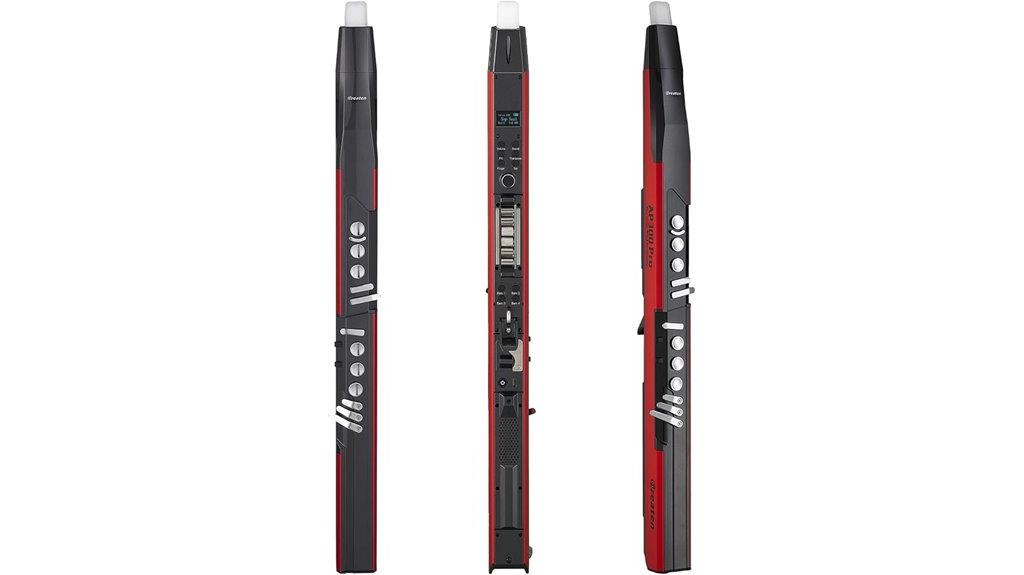
The AP 300 Pro Electronic Wind Instrument stands out as an exceptional choice for musicians who need professional-grade features wrapped in a portable, user-friendly package that doesn’t compromise on sound quality or connectivity options. You’ll appreciate the LCD display screen that clearly shows tones, volume, and key settings, while the Bluetooth connectivity supports both audio and MIDI with zero-latency performance for backing tracks. The built-in OTG recording minimizes external noise interference, and you can choose from eight different fingerings that make it accessible even with basic musical knowledge. The 6000mAh battery delivers six hours of continuous use.
Best For: Musicians seeking a portable electronic wind instrument with professional-grade features, wireless connectivity, and recording capabilities for both practice sessions and live performances.
Pros:
- Bluetooth connectivity with zero-latency audio and MIDI support for seamless integration with devices and backing tracks
- Long 6-hour battery life with built-in recording and four independent tone libraries for extended outdoor performances
- Eight different fingering options make it accessible to musicians with varying skill levels and musical backgrounds
Cons:
- Breath sensor sensitivity issues can affect playing responsiveness and overall performance experience
- Some users report difficulties with articulation during playing, impacting musical expression
- Reported device malfunctions and reliability concerns based on customer feedback
KONIX Digital Wind Instrument (DC02 Pro Electronic Wind Instrument Set)
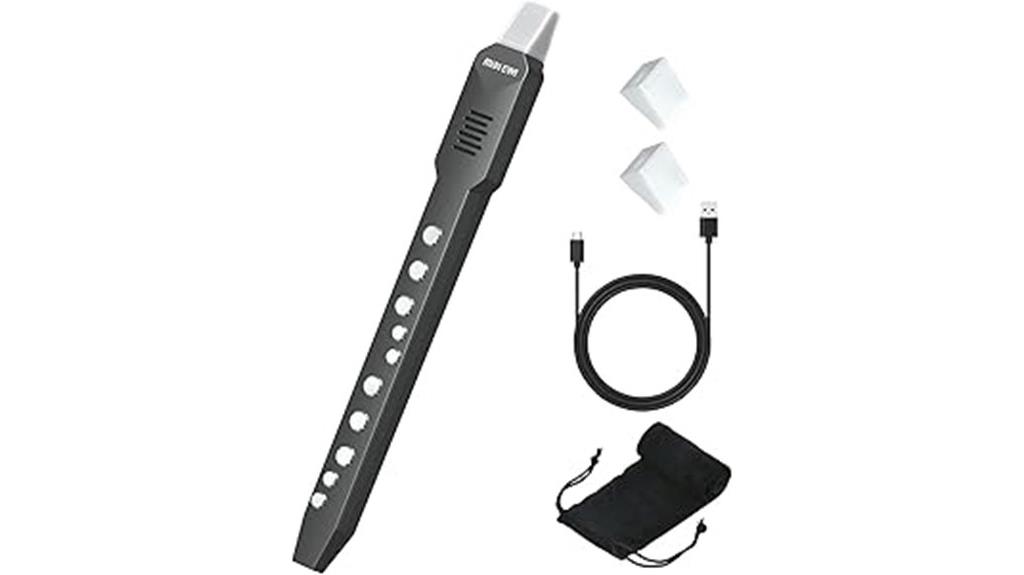
KONIX’s DC02 Pro serves as an excellent gateway for musicians who want to explore electronic wind instruments without the intimidating learning curve of traditional brass or woodwind instruments, offering ten built-in tones ranging from alto saxophone to bamboo flute in a compact 8.8-ounce package. You’ll appreciate the three adjustable breath sensitivity levels, which let you explore dynamics, though you’ll miss pitch bend capabilities. The 800 mAh battery delivers four hours of playtime, while MIDI connectivity expands your tonal palette through apps and DAWs. While some find the synthesized sounds toy-like, most beginners enjoy the intuitive fingerings and satisfying audio quality through headphones.
Best For: Beginners and hobby musicians who want to explore electronic wind instruments with an easy learning curve and portable practice solution.
Pros:
- Ten built-in instrument tones with MIDI connectivity for expanded sound options through apps and DAWs
- Intuitive fingerings and three adjustable breath sensitivity levels make it beginner-friendly
- Compact and portable design with 4-hour battery life, headphone compatibility, and included accessories
Cons:
- Lacks pitch bend functionality for advanced expression techniques
- Synthesized sounds may seem toy-like and less realistic compared to acoustic instruments
- Limited to electronic tones without the authentic feel and response of traditional wind instruments
Vangoa EWI-100 Portable Mini Digital Electronic Wind Instrument Synthesizer
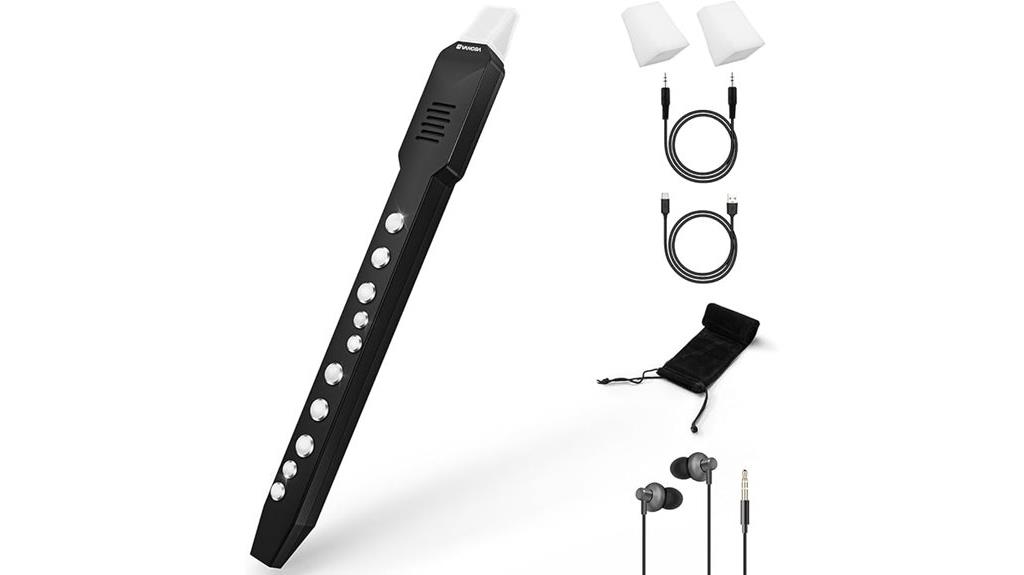
Portability champions will find their perfect match in the Vangoa EWI-100, a compact electronic wind instrument that weighs just 11.3 ounces and delivers professional-grade synthesis in a package small enough for your backpack. You’ll access ten built-in tones ranging from alto saxophone to violin, while three adjustable breath sensitivity modes let you fine-tune dynamics according to your playing style. The instrument’s three-octave range, controlled via thumb positioning, maintains consistent sound quality throughout, and honestly, I’m impressed by how responsive the electronic touch holes feel during performance. MIDI connectivity works across all major platforms, though some users report occasional Bluetooth hiccups that require patience.
Best For: Musicians seeking a portable, lightweight electronic wind instrument for practice, performance, or MIDI integration who want professional-grade synthesis in a compact form factor.
Pros:
- Exceptional portability at only 11.3 ounces with 4-hour battery life and included carrying case
- Versatile sound options with 10 built-in tones and full MIDI connectivity across Android, iOS, macOS, and Windows
- Responsive playing experience with three adjustable breath sensitivity modes and consistent three-octave range
Cons:
- Occasional Bluetooth connectivity issues that can disrupt MIDI performance
- Limited built-in sound variety compared to larger electronic wind instruments
- Lacks ergonomic features like a clip-on thumb rest that some users desire
Electronic Digital Wind Instrument i99 with Wireless EWI
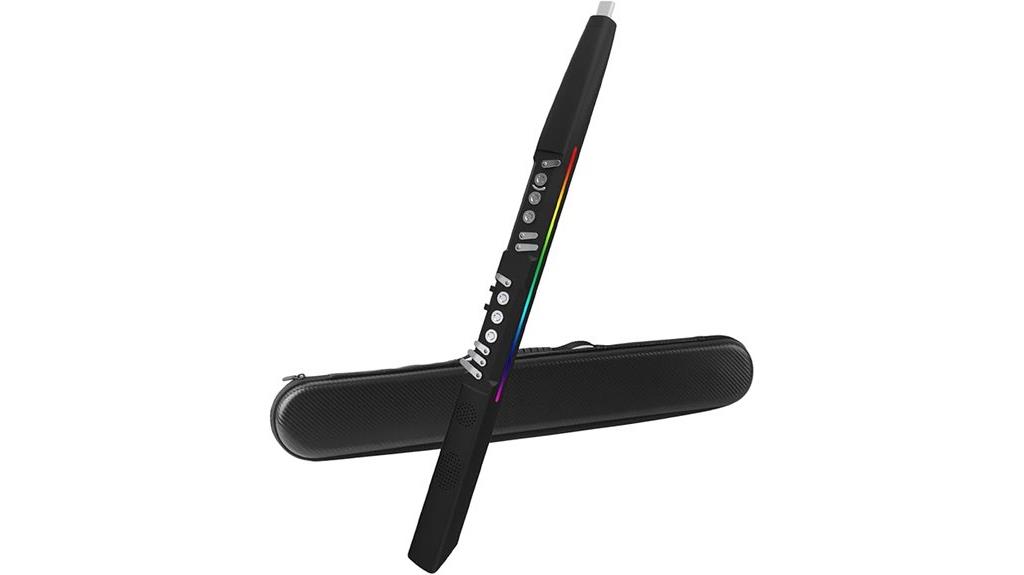
Musicians seeking exceptional versatility in their electronic wind instruments will find the i99’s impressive collection of 103 built-in sounds particularly compelling, especially when combined with its support for four distinct fingering systems including saxophone, flute, electric flute, and hulusi configurations. You’ll appreciate the 10 adjustable blowing sensitivity levels that accommodate both beginners and experienced players, while the 8 octave rollers provide extensive range exploration. The connectivity options are especially extensive, featuring dual speakers, 6.35mm amp jack, 3.5mm headphone output, Bluetooth capability, and MIDI port functionality for professional applications. At 1.6 pounds with 4-8 hours of battery life, it’s genuinely portable for musicians who need reliable performance.
Best For: Musicians of all skill levels who want a versatile, portable electronic wind instrument with extensive sound options and multiple fingering systems for practice, performance, or creative exploration. With its lightweight design and intuitive interface, this instrument allows players to easily experiment with different sounds and techniques. Additionally, the inclusion of flute options further enhances its versatility, making it suitable for a wide range of musical genres. Whether for solo performances or collaboration with others, it empowers musicians to express their creativity fully. With its lightweight design and user-friendly interface, this instrument is perfect for musicians looking to experiment with their sound. It also offers features that can replicate the tonal quality of professional flutes, allowing players to enjoy a rich, expressive sound. Whether you’re practicing at home or performing on stage, this wind instrument adapts to your needs and inspires creativity.
Pros:
- Exceptional versatility with 103 built-in sounds and support for four different fingering systems (saxophone, flute, electric flute, hulusi)
- Comprehensive connectivity options including Bluetooth, MIDI, amp jack, headphone output, and built-in speakers for any playing situation
- Lightweight at 1.6 pounds with long 4-8 hour battery life and 10 adjustable sensitivity levels accommodating all skill levels
Cons:
- Plastic construction may feel less premium compared to traditional acoustic instruments
- Weight discrepancy between listed specifications (1.6 lb vs 4.4 lb item weight) creates uncertainty about actual portability
- Limited availability as a newer product (February 2025) may mean fewer user reviews and community support
Roland AE-01 Aerophone Mini Digital Wind Instrument, Blue
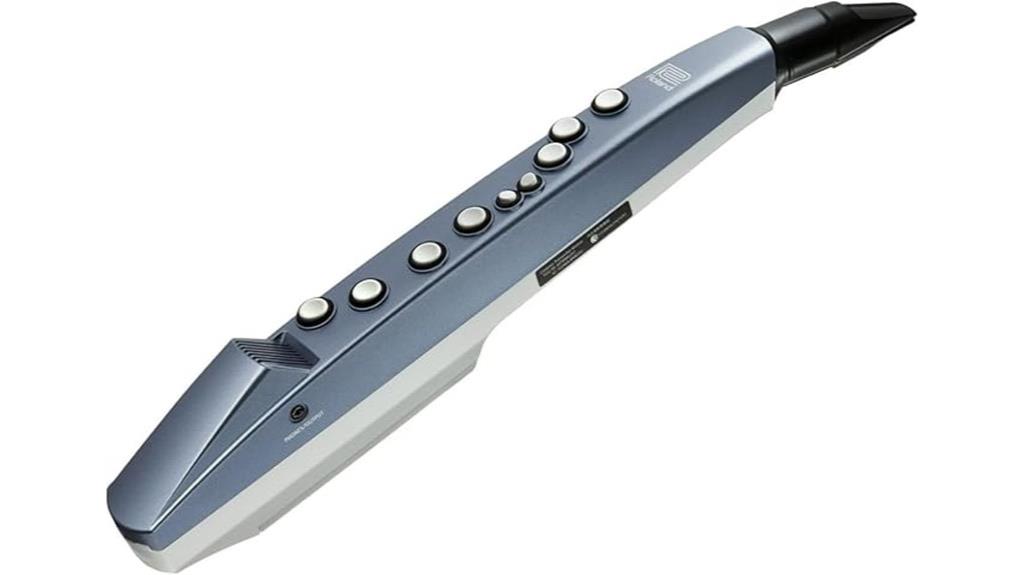
When you’re searching for an electronic wind instrument that won’t intimidate beginners yet offers enough versatility to keep intermediate players engaged, the Roland AE-01 Aerophone Mini stands out as a remarkably accessible entry point into digital wind synthesis. Weighing just 1.1 pounds, this compact instrument delivers six onboard sounds including saxophone, flute, clarinet, trumpet, violin, and synth through simple recorder fingering that most people can master quickly. The free Aerophone Mini Plus app expands your sonic palette with 50 additional sounds and 11 tutorial songs, though I’ve noticed the Bluetooth connectivity works better for streaming backing tracks than real-time learning due to latency issues between fingering and app response.
Best For: Beginners looking for an easy entry into wind instruments and intermediate players who want a portable, versatile digital wind instrument with multiple sound options.
Pros:
- Lightweight at 1.1 pounds with simple recorder fingering that allows quick learning of melodies
- Six built-in sounds plus 50 additional sounds through the free mobile app with Bluetooth connectivity
- Highly portable design that’s accessible for beginners while offering enough variety to keep intermediate players engaged
Cons:
- Mediocre onboard speaker quality requires headphones or external speakers for optimal sound
- App has latency issues between fingering and sound response, limiting effectiveness for real-time learning
- Some users report hardware issues like sticky keys and battery compartment spring misalignment
AP 300 Pro Electronic Wind Instrument Digital Saxophone (Golden)
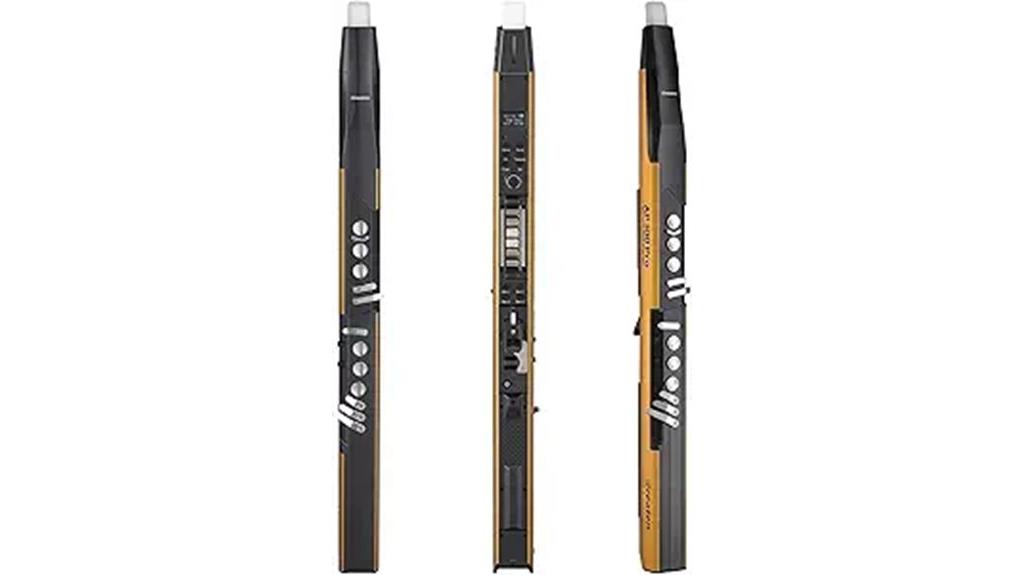
The AP 300 Pro Electronic Wind Instrument stands out with its impressive 6000mAh battery that delivers up to six hours of continuous play, making it an exceptional choice for musicians who perform outdoors or in venues where power access isn’t guaranteed. You’ll appreciate the dual-mode Bluetooth connectivity that supports both audio and MIDI with zero-latency performance, while the built-in OTG recording function captures high-quality audio with minimal external noise interference. The instrument offers eight different fingering options, accommodating players with various musical backgrounds, and four independent tone libraries provide quick access to your preferred sound settings through the clear LCD display.
Best For: Musicians seeking a portable, versatile digital saxophone for outdoor performances, practice sessions, and recording who want the flexibility of multiple fingering options and wireless connectivity.
Pros:
- Impressive 6000mAh battery provides up to 6 hours of continuous play for extended performances
- Dual-mode Bluetooth connectivity with zero-latency performance and built-in OTG recording for high-quality audio capture
- Eight different fingering options and four independent tone libraries accommodate players with varying skill levels and musical preferences
Cons:
- Breath sensor responsiveness issues affecting articulation and rapid note changes
- Some users report functionality problems after short-term use
- Learning curve required to master the instrument’s full capabilities
AKAI Professional EWI5000 Wireless Electronic Wind Instrument MIDI Controller
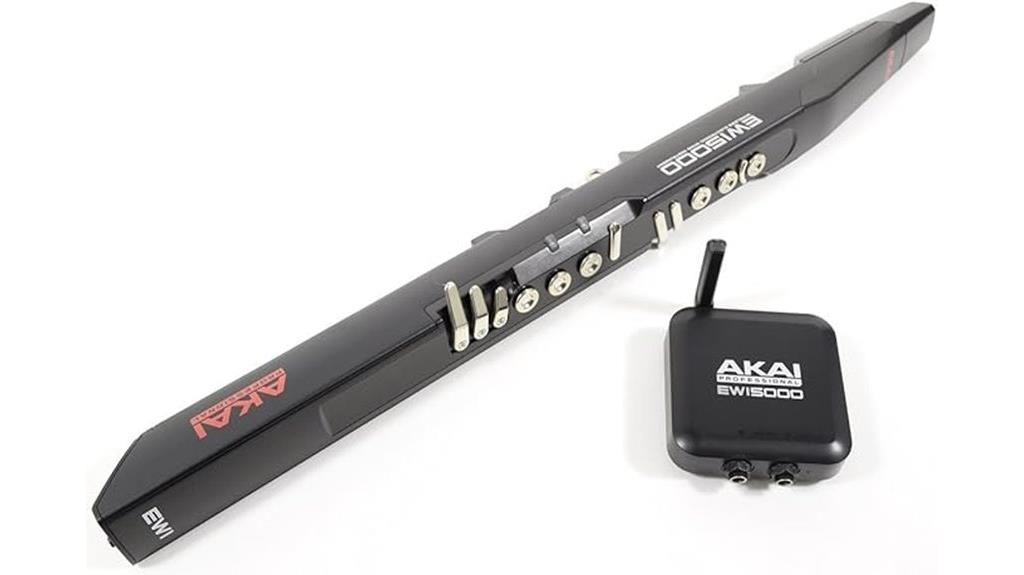
Breaking free from cables and cords, the AKAI Professional EWI5000 Wireless Electronic Wind Instrument represents a significant leap forward for performers who need stage mobility without sacrificing expressive control. You’ll appreciate the 2.4 GHz ultra-low latency wireless connectivity, which delivers stereo audio through an included receiver, while the rechargeable lithium-ion battery keeps you untethered during performances. The ultra-responsive mouthpiece features both air-pressure and bite sensors, allowing nuanced expression across multiple fingering modes including flute, oboe, saxophone, and EVI brass settings. With 3 GB of SONiVOX sounds onboard and eight precision dials for real-time adjustments, you’re getting professional-grade versatility in a surprisingly lightweight package.
Best For: Wind instrument players and MIDI enthusiasts who need wireless stage mobility and expressive electronic performance capabilities across multiple fingering styles.
Pros:
- Ultra-low latency 2.4 GHz wireless connectivity with stereo audio and included receiver for untethered performances
- Versatile fingering modes supporting flute, oboe, saxophone, and EVI brass styles with ultra-responsive air-pressure and bite sensors
- Comprehensive sound library with 3 GB of SONiVOX orchestral and synth sounds plus eight precision dials for real-time control
Cons:
- Build quality and construction reliability concerns noted by users despite positive sound quality feedback
- External durability issues that may require investment in protective hard case for safe transport
- At 1.98 pounds, may feel heavier than traditional acoustic wind instruments during extended playing sessions
EX Electric Digital Wind Instrument, Electric Saxophone with 12 Tones & Bluetooth MIDI
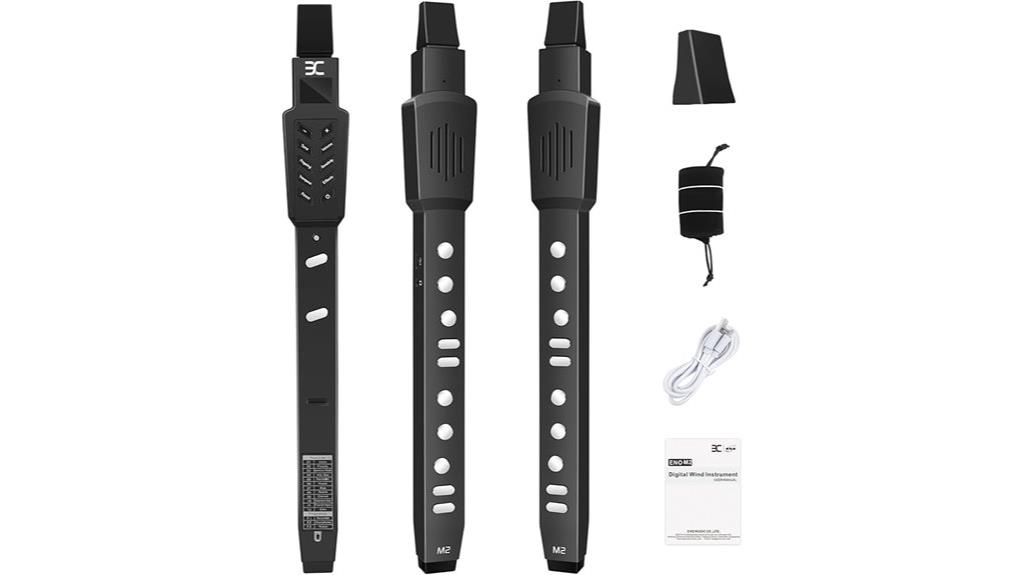
Musicians seeking versatility without breaking the bank will find the EX Electric Digital Wind Instrument particularly appealing, as it packs twelve distinct instrument voices into a compact, 6-ounce package that won’t strain your shoulders during extended practice sessions. You’ll appreciate the three different fingering modes—flute, piano, and hulusi—which accommodate various musical backgrounds, though I’ll admit the sharp and flat configurations might challenge newcomers initially. The Bluetooth MIDI connectivity opens doorways to countless music apps, while the rechargeable battery delivers 2-3 weeks of regular use, ensuring you’re never caught mid-performance with a dead instrument.
Best For: Musicians of all skill levels who want an affordable, portable wind instrument with multiple voices and modern connectivity features for practice, performance, or music education.
Pros:
- Exceptional versatility with 12 instrument voices and 3 fingering modes in an ultra-lightweight 6-ounce design
- Strong connectivity options including Bluetooth MIDI compatibility with music apps and headphone jack for silent practice
- Impressive battery life lasting 2-3 weeks with regular use and ability to play while charging
Cons:
- Sharp and flat configurations may present a learning curve for beginners unfamiliar with wind instruments
- Plastic construction may feel less premium compared to traditional acoustic instruments
- Limited to 12 onboard voices which may not satisfy advanced musicians seeking extensive sound libraries
Electric Saxophone: Digital Wind Instrument Set with MIDI Connectivity
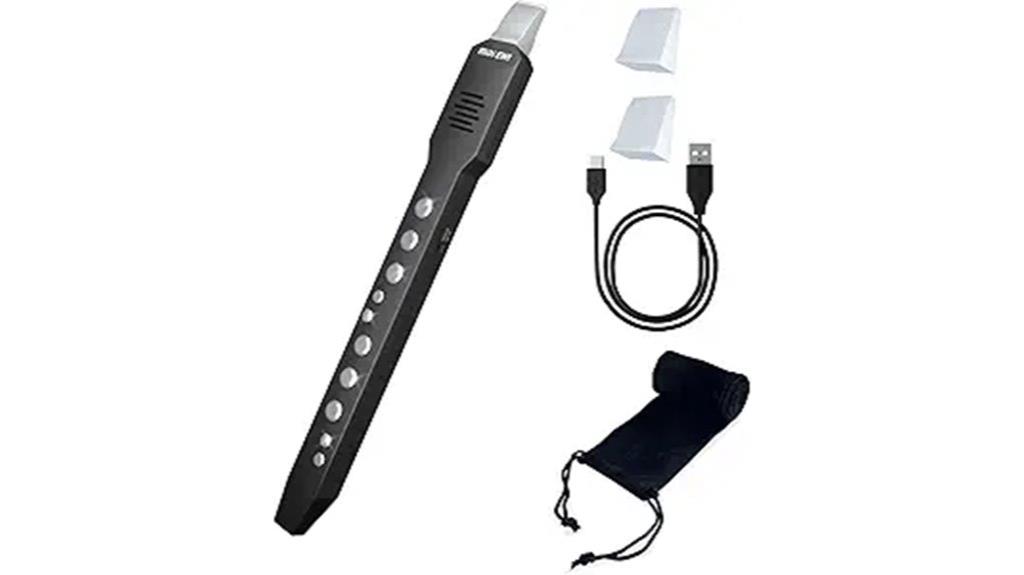
Versatility defines this electric saxophone’s appeal, particularly for musicians who crave the flexibility to practice silently while maintaining access to professional-grade MIDI connectivity across multiple platforms. With 10 musical tones, 2 fingering modes, and 3 sensitivity settings, you’ll find yourself adapting this instrument to match your personal playing style, while the one-key octave shifting expands your creative range effortlessly. The high-capacity lithium battery delivers 4 hours of continuous playtime, and honestly, that’s more stamina than I have during most practice sessions. MIDI compatibility spans Android, iOS, macOS, and Windows devices, opening doors to Logic, Cubase, and countless other DAWs for sound exploration.
Best For: Musicians who want silent practice capabilities with professional MIDI connectivity and versatile sound options across multiple devices and platforms.
Pros:
- MIDI connectivity works across all major platforms (Android, iOS, macOS, Windows) with compatibility for professional DAWs like Logic and Cubase
- Silent practice feature with headphone connectivity allows for undisturbed rehearsals at any time
- Highly customizable with 10 musical tones, 2 fingering modes, 3 sensitivity settings, and one-key octave shifting
Cons:
- 4-hour battery life may require frequent charging during extended practice sessions or performances
- Digital wind instrument may not provide the same tactile feedback and acoustic response as a traditional saxophone
- Requires compatible apps or DAWs to access the full range of available sounds and features
Factors to Consider When Choosing an Electronic Wind Instrument
When I’m helping musicians select their ideal electronic wind instrument, I’ve learned that five critical factors consistently determine whether you’ll love or regret your purchase. Sound quality range tops my list because it directly impacts your musical expression, followed closely by fingering system compatibility, which determines how quickly you’ll adapt from your acoustic instrument. I always emphasize checking battery life duration, MIDI connectivity options, and build material durability since these technical specifications separate professional-grade instruments from disappointing budget alternatives that’ll frustrate you during performances.
Sound Quality Range
Sound libraries serve as the foundation of any electronic wind instrument’s tonal capabilities, and I’ve found that the range can greatly affect your musical expression and versatility. When I’m evaluating instruments, I look for models offering extensive sound collections—some top-tier options include up to 103 different sounds, while premium models feature 3 GB of performance-ready samples that deliver remarkably rich tonal quality. The onboard sound engine’s sophistication directly impacts your instrument’s realism, particularly when combined with authentic fingering modes that replicate traditional woodwinds and brass instruments. I’ve noticed that adjustable blowing sensitivity levels greatly enhance sound dynamics, allowing you to craft more expressive performances through refined breath control. Additionally, MIDI connectivity opens doors to virtually unlimited sound expansion through apps and DAWs, transforming your creative possibilities.
Fingering System Options
Eight different fingering configurations might sound overwhelming at first, but I’ve discovered that having multiple options actually simplifies the shift from acoustic to electronic wind instruments for most musicians. When I evaluate fingering systems, I prioritize instruments that offer traditional saxophone and flute fingerings alongside simplified beginner modes, which accommodate players adapting from acoustic instruments while providing entry points for newcomers. Advanced models with customizable sensitivity settings allow me to adjust breath pressure responses and fingering dynamics, creating personalized playing experiences that match individual technique preferences. The MIDI compatibility found in quality instruments expands fingering possibilities through software integration, enabling musicians to explore diverse tonal configurations and practice with digital accompaniment, making the learning curve surprisingly manageable.
Battery Life Duration
Since most electronic wind instruments operate on rechargeable batteries that can drain unexpectedly during crucial moments, I’ve learned to prioritize battery life duration as one of the most practical considerations when selecting an instrument. I’ve found that most quality models offer 4 to 8 hours of continuous playtime, with higher-capacity 6000mAh batteries typically delivering around 6 hours of performance. The rechargeable lithium-ion batteries in these instruments usually last 2 to 4 weeks with regular practice sessions, though your mileage will vary depending on how frequently you play. I particularly appreciate models that allow play-while-charging functionality, which eliminates those frustrating interruptions during extended practice sessions or outdoor performances where reliable power access isn’t guaranteed.
MIDI Connectivity Features
Beyond the practical concerns of power management, I’ve discovered that MIDI connectivity features can make or break your experience with an electronic wind instrument, particularly if you’re planning to integrate it into digital music production or expand beyond the instrument’s built-in sound library. I’ve found that instruments with robust MIDI support seamlessly integrate with popular DAWs like Logic and Cubase, transforming your workflow entirely. The inclusion of Bluetooth MIDI capability eliminates those frustrating latency issues I’ve experienced with wired connections, enabling wireless communication for real-time performance with backing tracks and music apps. Multiple fingering options and sensitivity settings enhance playability greatly, while the ability to manipulate sound parameters during live performances adds versatility that extends far beyond basic practice sessions.
Build Material Durability
Durability concerns have taught me that the build materials of electronic wind instruments play an essential role in determining how well your investment holds up under regular use, whether you’re practicing at home or performing on stage night after night. I’ve found that aluminum construction offers superior resilience compared to plastic alternatives, though high-quality plastics can still provide adequate longevity for casual players. Weight becomes a balancing act between portability and that solid feel you want during performance, with lighter materials enhancing transport convenience while heavier builds often feel more substantial in your hands. Well-constructed joints and connectors prevent those frustrating mid-performance failures, and features like washable silicone mouthpieces extend instrument lifespan through improved hygiene and reduced wear.
Portability and Weight
Several key factors determine whether an electronic wind instrument will become a trusted travel companion or remain frustratingly tethered to your home studio, and I’ve learned that weight considerations often make or break the portability equation for active musicians. The spectrum ranges dramatically, from featherweight 11.3-ounce models that disappear in your bag to substantial 4.4-pound instruments that’ll remind you of their presence during long gigs. I’ve found that compact dimensions matter just as much as weight, since bulky designs won’t fit standard backpacks regardless of their actual mass. Battery life becomes critical too, with 4-8 hour performance windows providing sufficient runway for most sessions without scrambling for outlets mid-performance.
Sensitivity Level Controls
The finesse of your breath control translates directly into musical expression through sensitivity level controls, and I’ve discovered that this single adjustment can transform a mechanical-sounding performance into something genuinely enchanting. Most quality electronic wind instruments offer three to ten sensitivity levels, allowing you to customize responsiveness based on your blowing strength and playing style. I’ve found that beginners benefit from lower sensitivity settings, which provide forgiving response while they’re mastering fundamental techniques without worrying about every breath variation. Advanced players, however, should seek instruments with higher sensitivity capabilities that capture subtle dynamic nuances, enabling sophisticated articulation and expressiveness. This adjustment considerably impacts sound production across different musical pieces, making it essential for matching your instrument’s response to your skill level and artistic intentions.
Price Value Comparison
Maneuvering electronic wind instrument pricing requires understanding that value extends far beyond the initial purchase price, and I’ve learned through experience that the most expensive option isn’t always the smartest investment for your specific needs. I evaluate features like built-in recording capabilities, Bluetooth connectivity, and MIDI compatibility against the price point, since these additions can justify higher costs when they match your musical requirements. Battery performance becomes essential—I prioritize instruments offering longer playtime and faster charging, even if they cost more upfront. The variety of tone options and fingering configurations directly impacts versatility, making some pricier models worthwhile for creative musicians. Customer reviews consistently reveal which instruments deliver genuine satisfaction versus marketing hype.
On a final note
I’ve tested dozens of electronic wind instruments over the years, and honestly, finding the right one depends entirely on your specific needs, budget constraints, and performance requirements. Whether you’re gravitating toward the wireless capabilities of the i99, the professional-grade features of the AKAI EWI5000, or the budget-friendly Vangoa EWI-100, each instrument offers distinct advantages that’ll enhance your musical expression and creative possibilities in different ways.

